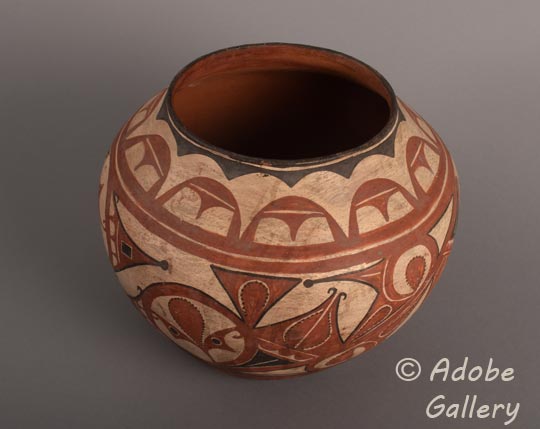Zia Pueblo Jar with Trios Polychrome Designs in Predominant Red Pigment
+ Add to my watchlist Forward to Friend
Forward to Friend
- Category: Historic
- Origin: Zia Pueblo, Tsi-ya
- Medium: clay, pigment
- Size: 10 “ height x 11-¼” diameter
- Item # C4945C
- Price: $9500
Zia and Trios Polychrome Pottery: A Unique Transition Piece
This historic pottery jar is a fascinating example of a transitional piece, showing characteristics of both late Trios Polychrome (1820-1860) and early Zia Polychrome (1860-present) styles. Noted pottery expert Francis Harlow dated this specific jar to 1870-1880, placing it squarely in this period of artistic change. In a later examination, it has been dated to 1920-1930. This change is a result of an identical jar in the School for Advanced Research collection that is dated to the later date. That jar was a gift from Amanda E. White in 1937.
Design and Pigment
The jar's design elements, such as the spirals containing trefoil leaves and the triangular attachments, are typical of the Trios Polychrome style. A unique feature is the small black rectangle within the red triangle that is attached to the trefoil element has been identified as a bird's eye.
What makes this jar particularly striking is the potter's innovative use of color. While Trios Polychrome pottery is generally characterized by an extensive use of black pigment, this piece is an exception. The bold design is a result of the dominant use of red pigment, with black used minimally for outlining. This reversal of traditional pigment use is seen in the "stylized feather caps" on the neck, which are red instead of the usual black. The black rectangle nestled in the red triangle, a detail often presented in red on dough bowls, is another instance of this intentional color inversion. This choice elevates the jar, making it a unique and strikingly beautiful departure from the standard Trios style.
Form and Execution
The jar's form is a strong and well-executed olla (a type of jar) with a high shoulder and an upturned rim. The quality of its execution reflects the improvements seen in the Zia Polychrome period. Several factors distinguish Zia from Trios pottery, including:
-
Volute Motifs: The spiral or scroll-like designs (volutes) on Zia Polychrome wares are much more precise and elaborate.
-
Underbody Polish: The area below the red band on Zia Polychrome jars is typically better polished, contributing to an overall more pleasing and refined finish.
Ultimately, this jar combines the elegant design of the Trios Polychrome period with the improved precision and craftsmanship of the later Zia Polychrome period, representing a masterfully crafted piece from a pivotal moment in the history of Zia Pueblo pottery.
The Evolution of Pottery Styles
While authorities assign specific periods to pottery styles, it's important to remember that potters didn't always make changes simultaneously. For example, a potter working in 1855 during the Trios Polychrome period might have continued to use that style for decades, even as the Zia Polychrome designation came into effect. These stylistic designations were created by pottery experts for study purposes and were not strictly observed by the potters themselves.
This is an exceptionally exquisite jar created about 100 years ago by a potter who chose to depart from tradition in color choice but followed tradition in design execution. She was talented, artistic, and daring. Today, we are the beneficiary of her talents. This jar is attributed to Isabel Medina Toribio (c. 1882-1940) Aitiyé.
Condition: this Zia Pueblo Jar with Trios Polychrome Designs in Predominant Red Pigment is in very good condition. UV examination reveals no repairs or restoration.
Provenance: this Zia Pueblo Jar with Trios Polychrome Designs in Predominant Red Pigment is from the estate of an East Coast resident of the United States.
Recommended Reading: The Pottery of Zia Pueblo by Harlow and Lanmon

- Category: Historic
- Origin: Zia Pueblo, Tsi-ya
- Medium: clay, pigment
- Size: 10 “ height x 11-¼” diameter
- Item # C4945C
- Price: $9500
Adobe Gallery Recommended Reading
Adobe Gallery Recommended Items
If you are interested in this item, we would also like to recommend these other related items:



